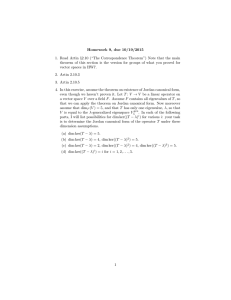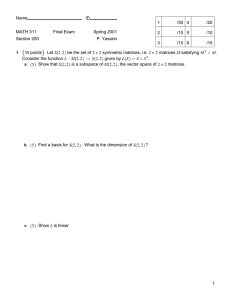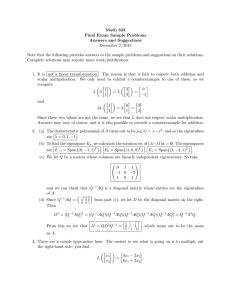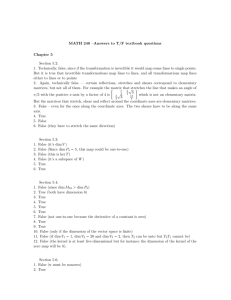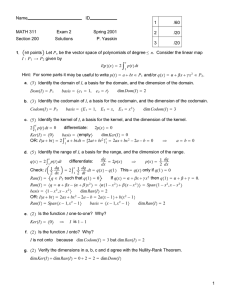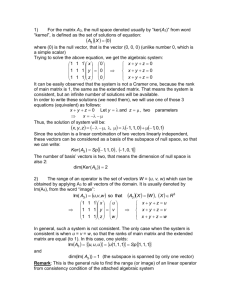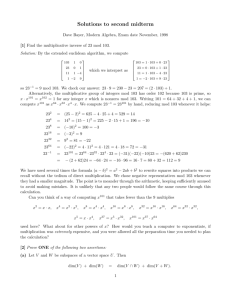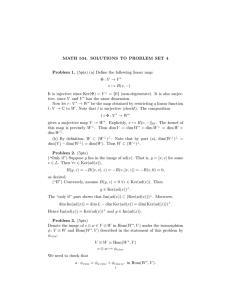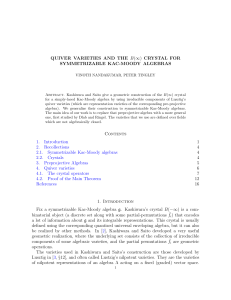Name ID 1 /10
advertisement
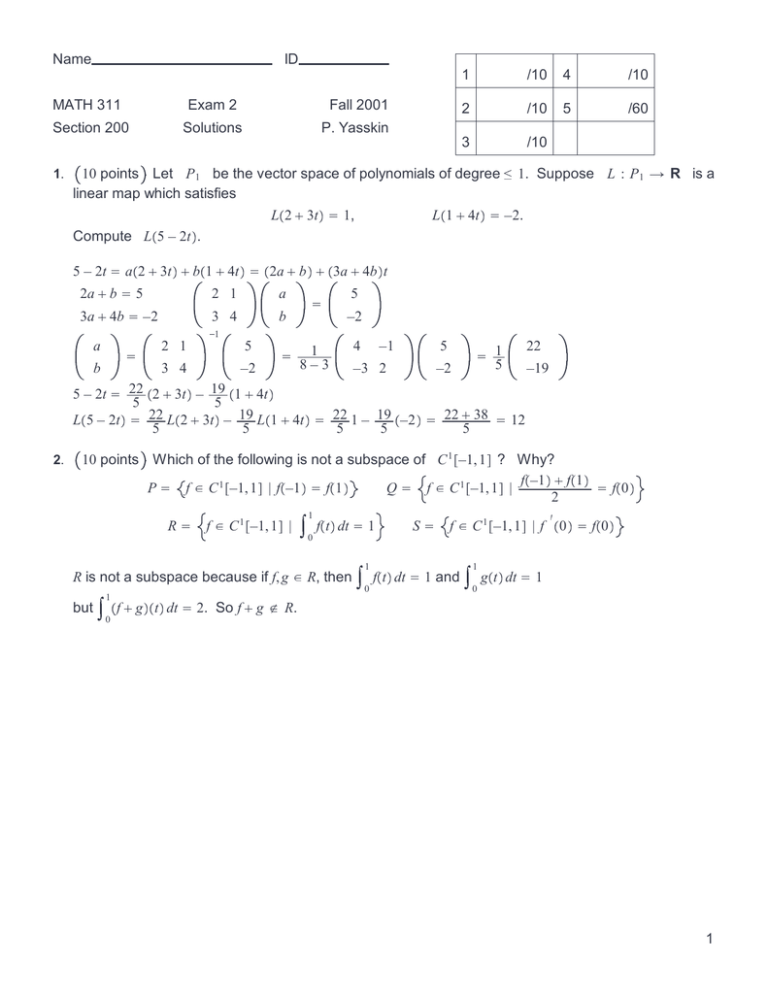
Name ID MATH 311 Exam 2 Fall 2001 Section 200 Solutions P. Yasskin 1. 1 /10 4 /10 2 /10 5 /60 3 /10 10 points Let P 1 be the vector space of polynomials of degree ≤ 1. Suppose L : P 1 linear map which satisfies L 1 + 4t = −2. L 2 + 3t = 1, Compute L 5 − 2t . 5 = 1 R is a 5 − 2t = a 2 + 3t + b 1 + 4t = 2a + b + 3a + 4b t 2a + b = 5 3a + 4b = −2 a b 3 4 a 3 4 b −1 2 1 = 2 1 5 −2 = = 1 8−3 5 −2 −1 4 −3 2 −2 5 22 −19 5 − 2t = 22 2 + 3t − 19 1 + 4t 5 5 L 5 − 2t = 22 L 2 + 3t − 19 L 1 + 4t = 22 1 − 19 −2 = 22 + 38 = 12 5 5 5 5 5 2. = f0 f ∈ C −1, 1 | f 0 = f0 10 points Which of the following is not a subspace of C 1 −1, 1 ? Why? f −1 + f 1 P = f ∈ C 1 −1, 1 | f −1 = f 1 Q = f ∈ C 1 −1, 1 | 2 R= f ∈ C −1, 1 | ∫ ft dt = 1 1 1 S= 0 1 ′ 1 1 R is not a subspace because if f, g ∈ R, then ∫ f t dt = 1 and ∫ g t dt = 1 1 0 0 but ∫ f + g t dt = 2. So f + g ∉ R. 0 1 3. 10 points Duke Skywater is flying the Millennium Eagle through the Asteroid Belt. At the current time, his position is ⃗r = 4, −1, 2 and his velocity is ⃗v = 3, 2, −1 . He measures that the electric field and its Jacobian are currently 12 ⃗= E and 2 ⃗= JE 9 2 0 1 0 4 3 . 1 2 9 Use a linear (affine) approximation to estimate what the electric field will be 2 sec from now. ⃗ ⃗r t E ⃗ ⃗r t 0 ≈E ⃗ + JE 12 ≈ 2 0 2 0 1 + 9 4. ⋅ ⃗rt − ⃗rt 0 4 3 ⋅ 1 2 9 10 points Let L : R 5 obtains the matrix R 4 ⃗ ⃗r t 0 ≈E 3 2 −1 2 = ⋅ ⃗ ⃗v t 0 t − t 0 + JE 12 2 5 +2 9 5 −2 22 = 12 5 be a linear map whose matrix is A. If A is row reduced, one 1 3 0 0 2 0 0 1 0 −1 0 0 0 1 2 0 0 0 0 0 What is the dimension of the kernel of L? Be sure to explain why. What is the dimension of the image of L? This has 2 free parameters since there are 2 columns without leading 1’s. dim ImL = # linearly independent columns = column rank = row rank Ker L = X ∣ AX = 0 So dim Ker L = 2. = # linearly independent rows = # leading 1’s = 3. It is OK to do one of these and then use the Nullity-Rank Theorem: dim Ker L + dim Im L = dim Dom L = 5. 2 5. 60 points Let M 2, 2 be the vector space of 2 × 2 matrices. Let P 2 be the vector space of P 2 given by polynomials of degree ≤ 2. Consider the linear map L : M 2, 2 LM = 1x M a b Hint: For some parts it may be useful to write M = a. 1 x and/or p x = α + βx + γx 2 . c d 3 Identify the domain of L, a basis for the domain, and the dimension of the domain. Dom L = M 2, 2 1 0 Basis_Dom L = 0 1 , 0 0 , 0 0 0 0 0 0 , 1 0 0 1 dim Dom L = 4 b. 3 Identify the codomain of L, a basis for the codomain, and the dimension of the codomain. CodomL = P Basis_CodomL = 1, x, x dim CodomL = 3 6 Identify the kernel of L, a basis for the kernel, and the dimension of the kernel. 2 2 c. L a b c d a b = 1x a b Ker L = M ∣ L M = 0 = = Span 0 1 x c d c d a + bx c + dx = 1x ∣ a + b + c x + dx 2 = 0 1 0 Basis_Ker L = −1 0 = a + b + c x + dx 2 1 −1 0 = 0 b −b 0 dim Ker L = 1 6 Identify the image of L, a basis for the image, and the dimension of the image. ImL = LM = a + b + c x + dx = Span1, x, x = P Basis_ImL = 1, x, x dim ImL = 3 e. 2 Is the function L one-to-one? Why? L is not one-to-one because KerL ≠ 0 . f. 2 Is the function L onto? Why? L is onto because ImL = P = CodomL . g. 2 Verify the dimensions in a, b, c and d agree with the Nullity-Rank Theorem. 1+3 = 4 dim KerL + dim ImL = dim DomL d. 2 2 2 2 2 3 h. 6 Find the matrix of L relative to the standard bases: (Call it A .) E←e 1 0 e1 = 0 0 0 1 e2 = , , 0 0 and E 1 = 1, a b L a b = 1x c d L e = x = E L e = x = E Le4 = x = E 6 Another basis for P 1 x c d L e1 = 1 = E1 2 2 3 2 2 i. 0 0 e3 = , 1 0 E 2 = x, 0 0 e4 = for M 2, 2 0 1 E 3 = x 2 for P 2 a + bx c + dx = 1x = a + b + c x + dx 2 1 0 0 0 A= 0 1 1 0 E←e 0 0 0 1 3 is F 1 = 1 + x, F 2 = 1 + x 2 , F 3 = x + x 2 . Find the change of basis matrices between the E and F bases. (Call them C and C .) Be sure to identify which is which! 2 F←E F1 = 1 + x = E 1 + E 2 1 1 0 C= F2 = 1 + x 2 = E 1 + E 3 F3 = x + x = E 2 + E 3 1 0 0 1 0 1 0 1 0 0 1 1 0 0 1 −1 R 2 3 1 0 1 E←F 2 1 1 0 E←F R2 R3 R1 0 1 1 1 0 1 0 1 0 0 1 1 0 0 1 1 1 0 1 0 0 1 0 1 0 1 0 0 1 1 0 −1 2 0 1 2 1 1 2 0 0 1 R 3 −R 1 −R 2 0 1 0 0 1 1 0 0 1 1 2 1 2 −1 2 0 1 0 0 0 1 1 1 −1 2 2 2 1 −1 1 C= 2 2 2 F E −1 1 1 2 2 2 j. 6 Consider the polynomial q = 2 + 4x. Find q E and F bases, respectively. Check q F . 1 0 0 −2 1 0 0 R 1 −R 3 R 2 −R 3 1 0 1 2 −1 2 1 2 1 −1 −1 −1 2 1 2 1 2 ← q = 2E 1 + 4E 2 q 2 E = 4 0 3F 1 − 1F 2 + 1F 3 = 3 1 + x − 1 1 + x 2 E and q F 1 2 1 q F =C q E = 2 F E −1 2 2 + 1 x + x = 2 + 4x = q ← , the components of q relative to the 1 2 −1 2 1 2 −1 2 1 2 1 2 2 4 0 3 = −1 1 4 k. 5 Find the matrix of L relative to the e basis for M2, 2 and the F basis for P . (Call it B .) 2 F←e B = F←e l. = C A F←E E←e 1 2 1 2 −1 2 −1 1 2 −1 2 1 2 2 1 2 1 2 1 2 1 2 −1 2 1 0 0 0 0 1 1 0 = 0 0 0 1 1 2 −1 2 1 2 1 2 −1 2 1 2 −1 2 1 2 1 2 5 Find B by a second method. F←e L e = x L e = x Le4 = x L e1 = 1 2 = dF 1 + eF 2 + fF 3 3 = dF 1 + eF 2 + fF 3 = gF 1 + hF 2 + iF 3 2 B= F←e m. = d1 + x + e1 + x + fx + x = d1 + x + e1 + x + fx + x = g1 + x + h1 + x + ix + x = aF 1 + bF 2 + cF 3 = a 1 + x + b 1 + x 2 + c x + x 2 1 2 1 2 −1 2 1 2 −1 2 1 2 1 2 −1 2 1 2 2 2 2 2 2 2 = 1 1 + x + 1 1 + x2 − 1 x + x2 −1 2 1 2 1 2 6 Consider the matrix N = 13 24 . Find N , the components of N relative to the e-basis and LN , the components of LN relative to the F basis. Use LN to find LN ? e F F 1 N= 1 2 = 1e 1 + 2e 2 + 3e 3 + 4e 4 3 4 N e = 2 3 4 1 1 1 −1 1 2 2 2 2 2 1 −1 −1 1 LN F = B N e = 2 2 2 2 3 F e −1 1 1 1 4 2 2 2 2 L N = 1F 1 + 4F 3 = 1 1 + x + 4 x + x 2 = 1 + 5x + 4x 2 n. ← 1 = 0 4 2 Recompute LN using the definition of L. LN = 1x 1 2 3 4 1 x 2 2 2 1 1 2 = 1+x − 1 + x + 1 x + x2 2 2 2 1 1 2 = 1+x − 1 + x + 1 x + x2 2 2 2 1 1 2 = − 1+x + 1 + x + 1 x + x2 2 2 2 = 1 + 5x + 4x 2 5
